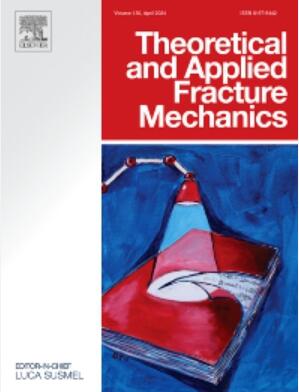带孔非持久性节理岩体的破坏特征和泄压效果
IF 5
2区 工程技术
Q1 ENGINEERING, MECHANICAL
引用次数: 0
摘要
在隧道工程中,岩体包含大量不规则分布的节理,通常具有较高的能量积累,因此存在发生岩爆的风险。因此,研究节理岩体的断裂扩展行为,评估钻孔泄压对缓解岩爆发生的影响,以采取有效的预防和控制措施至关重要。本文通过实验室测试和数值模拟,重点研究了非持久性节理岩体孔洞的破坏特征和泄压效果。在实验室实验中,岩样的制备包括一系列裂缝倾角和圆形孔洞。然后,利用 AE 和 DIC 技术研究了裂缝倾角和圆形孔的裂缝扩展规律。实验结果表明,随着裂纹倾角的增大,样品的峰值强度和能量变化先减小后增大。由于孔洞的存在,原裂纹的扩展方向发生了改变。钻孔后,试样的应变能明显降低,说明钻孔卸压效果明显,可有效降低岩体内部积聚的能量,降低岩爆风险。最后,利用 PFC 数值模拟软件,从裂隙与孔洞的相对位置、钻孔直径和钻孔间距三个方面分析了试样的微观破坏过程和能量变化规律。进一步了解节理岩体的能量耗散规律和力学行为特征,为探讨岩体的泄压效果和防止岩爆提供参考。本文章由计算机程序翻译,如有差异,请以英文原文为准。
Failure characteristics and pressure relief effectiveness of non-persistent jointed rock mass with holes
In tunnel engineering, the rock mass contains a significant number of irregularly distributed joints, and typically exhibits high energy accumulation, thereby posing a risk of rockburst occurrence. Therefore, it is of paramount importance to investigate the fracture propagation behavior in jointed rock masses and assess the impact of borehole pressure relief on mitigating rockburst occurrences for effective prevention and control measures. This paper focuses on failure characteristics and pressure relief effectiveness of non-persistent jointed rock mass with holes through laboratory testing and numerical simulation. In laboratory experiments, rock samples are prepared to include a range of crack dip angles and circular holes. Then, the crack propagation law of crack inclination and circular hole is studied by AE and DIC technology. The experimental results show that with the increase of fracture dip angle, the peak strength and energy change of the sample decrease first and then increase. Due to the existence of holes, the crack propagation direction of the original crack is changed. After drilling, the strain energy of the sample is obviously reduced, which shows that the drilling pressure relief effect is obvious, which can effectively reduce the energy accumulated inside the rock mass and reduce the risk of rockburst. Finally, the PFC numerical simulation software is used to analyze the micro-failure process and energy change law of the sample from three aspects: the relative position of cracks and holes, the diameter of boreholes and the spacing of boreholes. Further understanding of the energy dissipation law and mechanical behavior characteristics of jointed rock mass provides a reference for exploring the pressure relief effect of rock mass and preventing rockburst.
求助全文
通过发布文献求助,成功后即可免费获取论文全文。
去求助
来源期刊

Theoretical and Applied Fracture Mechanics
工程技术-工程:机械
CiteScore
8.40
自引率
18.90%
发文量
435
审稿时长
37 days
期刊介绍:
Theoretical and Applied Fracture Mechanics'' aims & scopes have been re-designed to cover both the theoretical, applied, and numerical aspects associated with those cracking related phenomena taking place, at a micro-, meso-, and macroscopic level, in materials/components/structures of any kind.
The journal aims to cover the cracking/mechanical behaviour of materials/components/structures in those situations involving both time-independent and time-dependent system of external forces/moments (such as, for instance, quasi-static, impulsive, impact, blasting, creep, contact, and fatigue loading). Since, under the above circumstances, the mechanical behaviour of cracked materials/components/structures is also affected by the environmental conditions, the journal would consider also those theoretical/experimental research works investigating the effect of external variables such as, for instance, the effect of corrosive environments as well as of high/low-temperature.
 求助内容:
求助内容: 应助结果提醒方式:
应助结果提醒方式:


